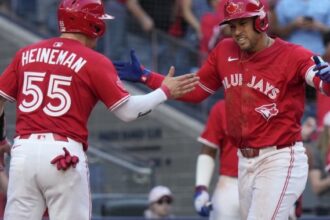The crisp evening air at Rogers Centre carried an undercurrent of tension as Kevin Gausman took the mound Thursday night. What followed was another troubling chapter in what has become a concerning June narrative for the Blue Jays’ ace. Gausman, who had been the reliable cornerstone of Toronto’s rotation, surrendered five runs over five innings in a deflating 9-4 loss to the Los Angeles Angels, extending his personal June slump and raising questions about the team’s pitching stability.
The numbers paint a stark picture. Gausman’s ERA has ballooned to 7.43 in June, a shocking departure from the dominance that earned him Cy Young Award consideration last season. His command—typically laser-precise—has abandoned him at critical moments, with location mistakes being punished mercilessly by opposing hitters. Against the Angels, his signature splitter lacked its usual devastating drop, hanging tantalizingly in the strike zone before being dispatched to the outfield corners.
“It’s frustrating because I feel like I’m making good pitches that are just getting hit,” Gausman said in a subdued post-game interview. “Baseball has a way of humbling you, and right now, I’m getting a full dose of that humility.”
The timing couldn’t be worse for a Blue Jays team desperately trying to find consistency in the competitive AL East. Toronto’s rotation, once considered among the league’s elite units, has faltered alongside their ace. The collective June ERA for Blue Jays starters has climbed above 5.50, placing immense pressure on an offense that has its own struggles with production.
What makes Gausman’s regression particularly perplexing is the absence of obvious mechanical flaws. His velocity remains steady, his arm angle consistent. Yet the effectiveness has vanished, suggesting the issue might be more subtle—perhaps a matter of pitch sequencing or telegraphing his intentions to increasingly prepared opponents. As noted in recent CO24 Trends analysis, this pattern of elite pitchers facing sudden adjustment periods has become increasingly common in today’s data-driven MLB.
The implications extend beyond just standings. Toronto invested heavily in Gausman as part of their competitive window, and his performance was meant to anchor their postseason aspirations. Now, management faces difficult questions about whether this is merely a temporary slump or a more concerning regression that might require intervention.
Blue Jays pitching coach Pete Walker has been working diligently with Gausman between starts, studying film and making minor adjustments. “Kevin’s too good for this to continue,” Walker insisted. “His track record speaks for itself. Sometimes it’s just a matter of finding that one small thing that’s off.”
The fanbase, meanwhile, oscillates between patience and panic. Social media has erupted with armchair analysis, some calling for dramatic changes while others counsel staying the course. This tension between immediate results and long-term perspective has become a central theme in Toronto’s sports discourse, as explored in our recent CO24 Opinions piece on fan expectations in rebuilding markets.
Beyond the technical aspects, there’s the psychological dimension. Pitching is as much mental as physical, and slumps can become self-perpetuating as confidence erodes. Gausman’s body language on the mound has changed—the assured presence replaced by visible frustration after missed locations. Breaking this cycle will require not just mechanical adjustments but rebuilding the mental foundation of his approach.
For Blue Jays manager John Schneider, the challenge is balancing support for his struggling ace while also securing wins in an increasingly competitive playoff race. “We believe in Kevin,” Schneider affirmed. “Great players go through tough stretches. His work ethic hasn’t changed, and neither has our confidence in him.”
The cultural impact of Gausman’s struggles resonates through Toronto’s passionate baseball community. In a city where sports success often shapes collective mood, the pitcher’s difficulties have become a metaphor for resilience in the face of unexpected challenges—a theme that extends beyond the diamond, as we’ve explored in CO24 Culture examinations of sports’ role in urban identity.
As the Blue Jays navigate this pitching crisis, the coming weeks will prove pivotal. Can Gausman recapture his form, or will the team need to pivot to alternative strategies? The answer may determine not just Toronto’s 2024 fate, but the trajectory of their competitive window for seasons to come. For a fanbase accustomed to both exhilarating highs and crushing disappointments, Gausman’s journey back to dominance represents both their immediate hopes and their perpetual resilience.


















